Phenom II Performance
The addition of the 955BE and 945 to the top of the Phenom II line now provides uncompromised choices of Phenom II in the midrange. As mentioned in the launch review, Phenom II is now the top performer in the midrange, with Core i7 owning the high-end. Even overclocking is once again an area where AMD need apologize to no one. The latest Phenom II cores are incredible overclockers, yielding even better performance. With the 955BE performance fresh on our radar, it was impossible not to choose the 3.2GHz 955BE as the heart of the latest Phenom II performance PC.
| AMD Phenom II Performance PC | ||
| Hardware | Component | Price |
| Processor | Phenom II x4 955 Black Edition (3.0GHz x4 125W 4x512KB L2, 6MB L3) |
$245 |
| Cooling | Xigmatek Dark Knight-S1283V | $40 |
| Video | MSI Radeon HD 4890 1GB - OC Edition (After $20 Rebate) | $230 |
| Motherboard | Gigabyte GA-MA790XT-UD4P AM3 (after $15 Rebate) | $125 |
| Memory | OCZ Extreme Edition 4GB (2x2GB) DDR3-1600 (PC3 12800) OCZ3X16004GK 7-7-7 ($83 less $30 Rebate) | $53 |
| Hard Drive | Western Digital Caviar WD1001FALS 7200RPM Sata 3/0Gb/s 1TB | $105 |
| Optical Drive | LG BD/HD DVD / 16x DVD+/- RW GGC-H20L - Retail | $109 |
| Audio | On Motherboard 8-channel | - |
| Case | Lian Li PC65B Black Aluminum Mid Tower | $100 |
| Power Supply | IN WIN Commander 750W SLI/CrossFire 80 Plus Modular ($140 less $50 Rebate) | $90 |
| Base System Total | $1097 | |
| Display | ASUS VW266H Black 25.5" 2ms(GTG) HDMI WUXGA LCD Monitor (1920x1200) ($350 less $30 Rebate) | $320 |
| Speakers | Logitech G51 155W RMS 5.1 Speakers - Retail | $135 |
| Input | Microsoft CA9-00001 Black PS/2 Standard Keyboard and Optical USB/PS2 Mouse - OEM | $16 |
| Operating System | Microsoft Vista Home Premium OEM | $99 |
| Complete System Bottom Line | $1667 | |
| SSD (Optional) | OCZ Vertex OCZSSD2-1VTX60G 2.5" 60GB SATA II MLC Internal Solid state disk | $209 |
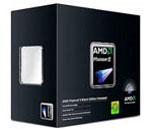 |
For detailed information on the Phenom II, please read yesterday's Phenom II X4 955 review. The Phenom II 955 at 3.2GHz is the fastest of the currently shipping AMD Phenom II processors, and it is built on a new stepping Phenom II 45nm core. The Phenom II is very similar in L2/L3 cache configuration to the Intel Core i7. Performance is also the best among today's midrange processors, and the 955 is only outperformed by the high-end Intel Core i7 series. As the latest 45nm AMD processor the Phenom II 955 also overclocks very well, matching or exceeding the very best Intel Core 2 Quad performance.
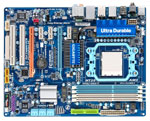 |
We've paired the Phenom II 940 with the new Gigabyte GA-MA790XT-UD4P motherboard based on the 790X chipset. The 790X is very similar to the 790GX chipset except it does not provide on-board graphics. It also supports the newest AM3 Phenom II processors and DDR3-1066/1333/1600 memory. Gigabyte combines the 790X with the latest AMD SB750 south bridge. This combo provides one x16 slot running at x16, a second x16 slot running at x8, three PCIe x1 slots, and two PCI slots. There are eight 3Gb/s SATA ports, a parallel port, and support for SATA RAID 0/1/5/10, 2600MHz HyperTransport, and maximum memory of 16GB in four slots.
The motherboard rear panel provides eight USB 2.0 ports, two Firewire, PS/2 keyboard and mouse, both optical and coax SPDIF out, and six audio jacks for the I-channel on-board audio. In addition there are two USB headers for internal USB and one additional 1394a (Firewire) header. The Gigabyte 790X board provides plenty of expansion capabilities for a performance AMD system, as well as excellent overclocking capabilities for those who plan to overclock.
The 790X chipset provides a single PCIe X16 slot and a PCIe x8 slot. This is fine for a single card and many will be happy with CrossFire that works as two PCIe x8 slots on the 790GX/X motherboards. However, if you have to have the very best CrossFire performance possible you should look for a motherboard based on the 790FX chipset, which does provide true dual PCIe x16 performance. This may be important to some, which is why we point it out. Otherwise, there is little to complain about with the performance of this Gigabyte AM3 motherboard.
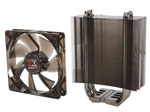 |
The Phenom II is not the hot CPU you find in the Core i7, but it still benefits from third party cooling - particularly if you plan to overclock with a CPU with OC capabilities like the 955BE. We paired the Phenom II 955BE with the same Xigmatek Dark Knight used in our value systems, which performed well in the lab. At $40 the Xigmatek is an excellent cooling value.
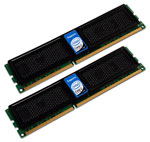 |
Since the Phenom II is dual-channel DDR3, the motherboard was populated with a 4GB kit of OCZ Intel Extreme Edition DDR3-1600. This memory is rated at 7-7-7 at DDR3-1600 and 9-9-9-at DDR3-1800. It is even faster at DDR3-1333 or DDR3-1066. Don't worry about the Intel designation as it will work fine with your new Phenom II 955BE. If you plan to extensively overclock you might have more flexibility choosing an even faster memory like DDR3-1800 or DDR3-2000, but our overclocking tests showed the highest memory speeds were somewhat wasted on the Phenom II and fast memory timings improved performance more. This fast and flexible memory gives both very fast timings and headroom when it is needed.
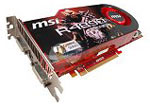 |
For the performance system, we upgraded the video card to ATI's latest Radeon HD 4890. As we stated in our review, the 4890 is basically a tweaked and overclocked 4870. It improves performance over the 4870 1GB and competes well with the GTX 275. On a pure performance level the 4890 and GTX 275 trade blows at different resolutions. MSI's overclocked HD 4890 bumps the clock speed up a little higher (880MHz instead of 850MHz), and with the current mail-in rebate it's $20 less than the GTX 275, so it gets our recommendation for the AMD performance build. Need even more power? Feel free to add a second card and run CrossFire. That should be enough for just about any current game at 2560x1600 (and is typically overkill for a 1080p display).
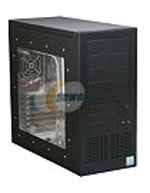 |
The case for the Phenom II performance system is a well-regarded Lian Li black all aluminum case. This Lian Li case has a reputation for being exceptionally quiet with its four 80mm fans with a fan speed controller and the excellent heat dissipation you expect from an all aluminum case. What is unique is the $40 savings on this case through the month of April, which reduces the cost to $100. There is even a side window for those who like a view of their working system.
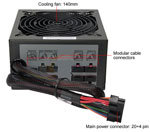 |
The power supply is the IN WIN Commander 750W modular with a 140mm double ball bearing cooling fan. This superb 80 plus certified power supply would be a bit rich for an upper midrange performance rig at a normal selling price of $140. However, there is currently a $50 rebate that reduces the net price to just $90. If this PSU interests you then grab it at this great price as we're sure the rebate will go away as more buyers discover this value.
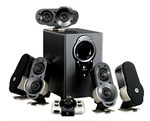 |
Most of our editors consider the onboard audio of motherboards to be adequate for even gaming these days. That is why we have not chosen a sound card for the performance midrange system. If you want more than that offered by onboard surround sound, the ASUS Xonar DX 7.1 is one of the top-performing audio cards on the market today. It is a great upgrade to the onboard sound if you want better sound quality. Game compatibility is excellent, but most game creators assume everyone has a Creative Labs sound card. If your main reason for having a powerful computer is gaming, you may prefer the Creative 7.1 Sound Blaster X-Fi Titanium at the same price. In our opinion, the sound quality is batter on the ASUS or an HT sound card, but game compatibility will never be a question with a Creative Labs sound card. We also upgraded to the Logitech G51 speakers. The Logitech rebate has ended, so the price is now $135 or so. They are still a decent value at that price.
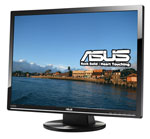 |
The LCD display resolution is still the 1920 horizontal of the 1080p value system, but the 26" displays run at a 16:10 aspect ratio and WUXGA (1920x1200). Regardless of the minor resolution differences, the size of the monitor is now 26", so everything on the screen is a little larger - great if your vision isn't the best. The ASUS VW266H 25.5" provides the preferred HDMI input, as well as DVI and an analog VGA port. Panel speed is rated at an incredible 2ms, but we have found most current LCD panels perform similarly and the speed rating does not really guarantee very much. The ASUS monitor provides a large sharp image, good colors, and fast panel speed at a very good price of $320 after rebate. It comes with DVI and VGA cables, but if you plan to connect with HDMI you will need to buy a separate HDMI cable. The ASUS is also available with a rotatable 2MB webcam attached for just $20 more.
The hard drive remains 1TB but we selected the Western Digital 7200RPM for the Phenom II performance system at $105. This was mainly a concession to those who bitterly complain whenever we choose the Seagate as our 1TB drive choice. The WD is an excellent 1TB drive and it has never had any issues with failure, where early Seagate 1TB drives were plagued with firmware issues. The Seagate drives with recent firmware have performed fine in our labs, but if you are a buyer who worries about that the WD is the better choice. Seagate still provides a 3-year warranty and our experience with filing for warranty service online with Seagate has been excellent. The choice is yours - the Seagate is $85 and the comparable WD is $105.
 |
The remaining components are the same as our value systems. The optical drive is the LG BD-ROM. The Microsoft OEM keyboard and optical mouse provide input and Vista Home Premium OEM runs the system. For more information on these components, you can refer to the descriptions on earlier pages.
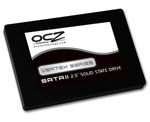 |
In response to those who have asked for SSD recommendations, it is possible to finally make SSD recommendations based on the months of research and testing performed on SSD drives at AnandTech. For more information on SSD test results please see our SSD Anthology and the SSD Update. In keeping with the midrange pricing, we have listed an SSD option of the 60GB OCZ Vertex for the Phenom II performance system, though you could use a larger Vertex SSD if it better meets your needs.










60 Comments
View All Comments
Proteusza - Tuesday, April 28, 2009 - link
Ha ha, since even the writer of the article questioned your integrity, I think its fair to say you are the greater troll than I.So wait... you are saying the benchmark doesnt count because its GPU bound, but you also say Phenom II is not a great gaming platform? Seems to me, that since the benchmark in question is of a GAME, that it kinda matters for determining how good it would be for gaming. And, as I said, you would be paying a few hundred dollars extra for 0.6FPS more. Now why would you do that? Nehalem may well overclock slightly better, but you said so yourself, its GPU bound, if the Phenom II gets to 3.8GHz and the Nehalem gets to 4.0GHz, its not gonna matter much.
Xeon and Opteron are enterprise CPUs you dolt, they require registered memory and special motherboards which are a lot more expensive. And the CPUs themselves are more expensive. Not a good gaming platform.
But really, what all of this shows is how pathetic you are, since even if AMD did release a CPU which beat Intel in every single way (and it has in the past, remember Athlon 64 vs Pentium D), you wouldnt buy it because you LOVE Intel. So I'm sure reading guides like this make you froth at the mouth, the idea that peope are buying AMD CPUs and not regretting it, but you know, thats your own fault.
tshen83 - Tuesday, April 28, 2009 - link
"Ha ha, since even the writer of the article questioned your integrity, I think its fair to say you are the greater troll than I."Only idiots let other people's opinions wash over your own thinking. Just because Jarred called me a troll doesn't mean he is right.
"So wait... you are saying the benchmark doesnt count because its GPU bound, but you also say Phenom II is not a great gaming platform? Seems to me, that since the benchmark in question is of a GAME, that it kinda matters for determining how good it would be for gaming. And, as I said, you would be paying a few hundred dollars extra for 0.6FPS more. Now why would you do that? Nehalem may well overclock slightly better, but you said so yourself, its GPU bound, if the Phenom II gets to 3.8GHz and the Nehalem gets to 4.0GHz, its not gonna matter much. "
Games are always GPU bound, and not well threaded enough. It would take a 7Ghz Phenom II to be comparable to i7 @4.0Ghz. Just because you can't tell a difference between two CPUs in some stupid games doesn't mean the two cpus are the same.
"Xeon and Opteron are enterprise CPUs you dolt, they require registered memory and special motherboards which are a lot more expensive. And the CPUs themselves are more expensive. Not a good gaming platform. "
Smart consumers are getting the enterprise features(IOAT, less power consumption, higher Tcase tolerance, more intel test validations) for free or cheaper even. There is not a single consumer CPU worth buying right now IMHO.
1. Nehalems don't need registered memory, only 2S Opterons do.(So get your facts straight before you badmouth me) 1S Opterons can use unbuffered DDR2 ECC ram also.
2.CPUs are often cheaper if you know which ones to buy: hint W3520 and E5504 and possibly E5520s. Those "server" CPUs are the best gaming platform money can buy right now. Only idiots would buy Phenoms because they think the naming must imply that the CPU is "Phenomenal" right? Did you know that all the good AMD CPUs ended up being Shanghai Opterons with synchronized integrated memory controller that scales linearly with CPU clock speed while consuming far less power? Phenoms are cheap because they are junk. Enterprise people won't buy Phenoms to power their workstations and servers, so the Dubai suckers ended up paying Anandtech to shove the Phenoms down idiots' throats, you know, people like you.
3. Dual Socket Nehalem boards can be found for about 230 now. Compared to $170 PhenomII class motherboards, it is not even close.
"But really, what all of this shows is how pathetic you are, since even if AMD did release a CPU which beat Intel in every single way (and it has in the past, remember Athlon 64 vs Pentium D), you wouldnt buy it because you LOVE Intel. So I'm sure reading guides like this make you froth at the mouth, the idea that peope are buying AMD CPUs and not regretting it, but you know, thats your own fault. "
Today's Intel isn't the Intel from PentiumD days. I had over 7 Athlon XP CPUs in my room during the PentiumD days, so please don't assume anything. I don't give a crap about Intel, and often critisize Intel's overpriced SSDs. Nehalems are hands down the best CPU since the Pentium Pros.
Last point: during an argument, don't start your offense or defense with the word "if", especially if the "if" is about "AMD release a CPU which beat Intel in every single way" It makes your whole statement false. Discreet Math 101.
JarredWalton - Saturday, April 25, 2009 - link
Not everyone needs even quad-core, let along quad-core plus Hyper-Threading. Spending $150+ to move from our performance (top-end) AMD Phenom II to a faster Core i7 920 is fine if you plan to do 3D rendering or video encoding, but most people won't notice the difference. We mentioned several times that i7 is the fastest current platform, but it's also the most expensive current platform.What is "inferior" about AMD Phenom II? Have you even used the platform, or are you looking at a few benchmarks and concluding it's "superior"? Or maybe that IN WIN PSU is "inferior"... tell me, who manufactures the IN WIN PSU? Most likely Enhance or Seasonic, given the look, and both are very good companies. IN WIN has been around a while, and that PSU launched at a price of over $200, so it's almost certainly a decent build, and an efficiency rating of over 80% gives you everything you need.
Your "dishonest" business claims are... well, I won't even bother responding to that. Basically, I'm with Wes: there's a lot of FUD being spread, with little to back it up. Who cares about Xeon processors when we're reviewing a consumer CPU? And on the server side, we've pretty clearly shown that AMD is hurting.
C'DaleRider - Sunday, April 26, 2009 - link
[quote]...tell me, who manufactures the IN WIN PSU? Most likely Enhance or Seasonic, given the look, and both are very good companies.[/quote]The proper answer is it a CWT PUC design, as attested to by JonnyGuru's test of the InWin Commander back in Jan. of this year.
Decent designed power supply, but has the usual CWT flaws...3.3V rail falls apart under high load, ripple/noise that increases to almost ATX spec limits under rated load, etc.
Not a bad supply but certainly not up to the standards of a good current designed Seasonic or Antec/Delta or Enermax build.
Summer - Sunday, April 26, 2009 - link
I would say that I'm an average consumer who uses the computer for web surfing, word processing, gaming, photoshopping and family video editing/encoding. From my experience, my 720x4 is already overkill compared to my dual core. I can't imagine the average user needing more than 4 cores for anything basic around the house. Even if the computer is for gaming, wouldn't the extra money be better used for a videocard?marraco - Friday, April 24, 2009 - link
I would like to see the gaming performance of the Phenom II 955BE + DDR2 + Radeon 4890 against the SAME price spent in i7.surely you need to downgrade video to stay on budget, so:
What is better: Phenom2 + 4890, or I7 + same budget video?
I bet on AMD!
MadMan007 - Saturday, April 25, 2009 - link
Obviously since in the real world game settings the video card determines the performance except in a very few games. Better video card = better gaming hasn't changed.DanStp1 - Friday, April 24, 2009 - link
I had an AM2 MB a couple of years ago, and I could not use all 4 memory slots with a big CPU cooler, like the ones in this article.Have the newer AM2 MB's been redesigned so that tall coolers clear all 4 memory slots?
If you have 4 slots but can not use them it limits the platform.
Thanks:)
icingdeath88 - Saturday, April 25, 2009 - link
This one is high enough off the motherboard that it clears the ram. By quite a bit too. It's more to do with the cooler design than the motherboard design, though. I would imagine that it might still have problems with ram with those big heatsinks or heatpipes on them.DanStp1 - Friday, April 24, 2009 - link
I have seen on other sites, that the southbridges on AMD chip sets, including the SB750, have poor SATA performance.Has AMD done anything to address this?
In particular I have read about ACHI issues, and NCQ problems.
Thanks:)